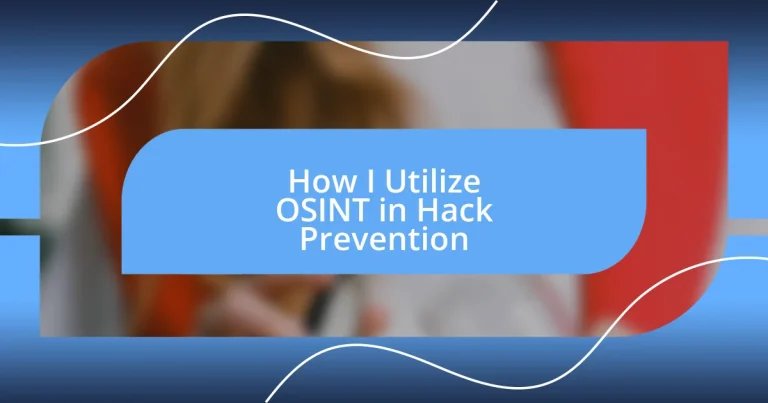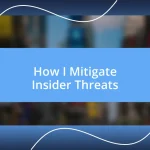Key takeaways:
- OSINT is a crucial tool in cybersecurity that allows for the gathering and analysis of information from public sources to prevent potential attacks.
- Utilizing key OSINT tools like Maltego and Shodan can unveil important insights and vulnerabilities, enhancing a proactive defense strategy.
- Continuous monitoring and updating of OSINT practices, along with case studies of successful interventions, illustrate the importance of adapting strategies to evolving cyber threats.
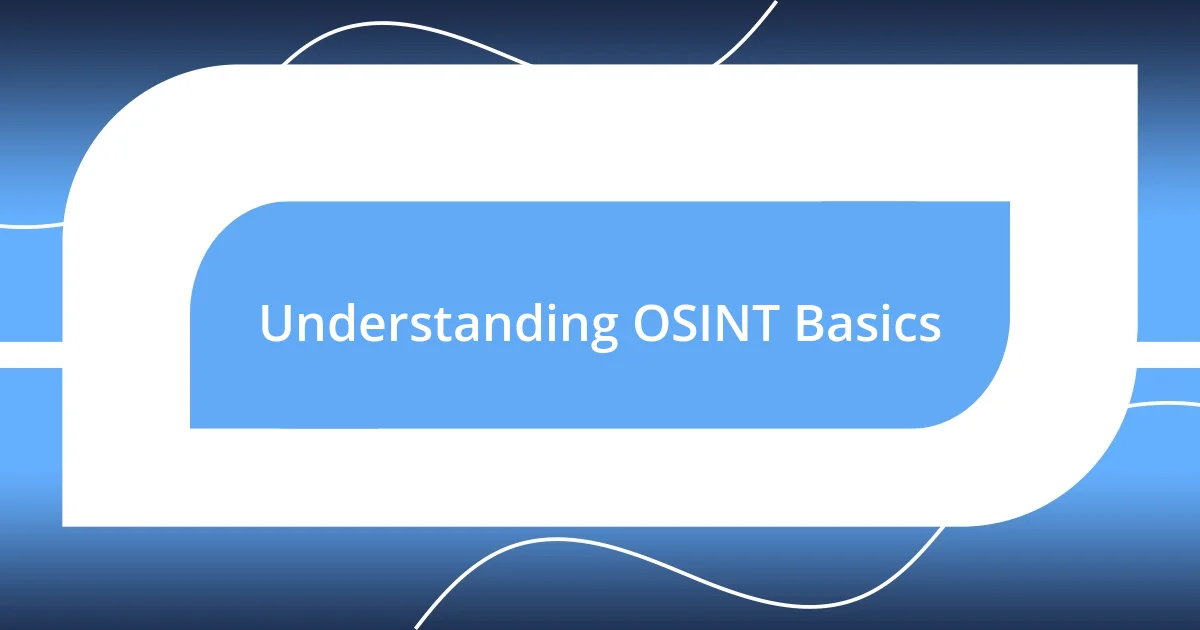
Understanding OSINT Basics
Open Source Intelligence (OSINT) refers to the gathering of information from publicly available sources, and it’s an incredibly powerful tool for anyone interested in cybersecurity. I remember my first experience with OSINT; I stumbled upon a treasure trove of information while researching a potential threat actor. It was like unearthing a hidden map that led me directly to clues about their behavior and patterns.
You might be wondering, why is OSINT so important? The answer lies in its accessibility and the vast array of sources available, from social media platforms to online forums. Every time I dig into a new case, I’m amazed at how much can be gathered simply by monitoring open channels. This treasure can either help me block a potential attack or uncover vulnerabilities in my own network.
In my experience, understanding how to navigate OSINT requires curiosity and a keen eye for detail. I often find myself thinking, “What can this seemingly innocuous piece of information lead to?” It’s essential not just to collect data but to analyze and interpret it wisely. After all, every detail counts when it comes to preventing a potential hack.
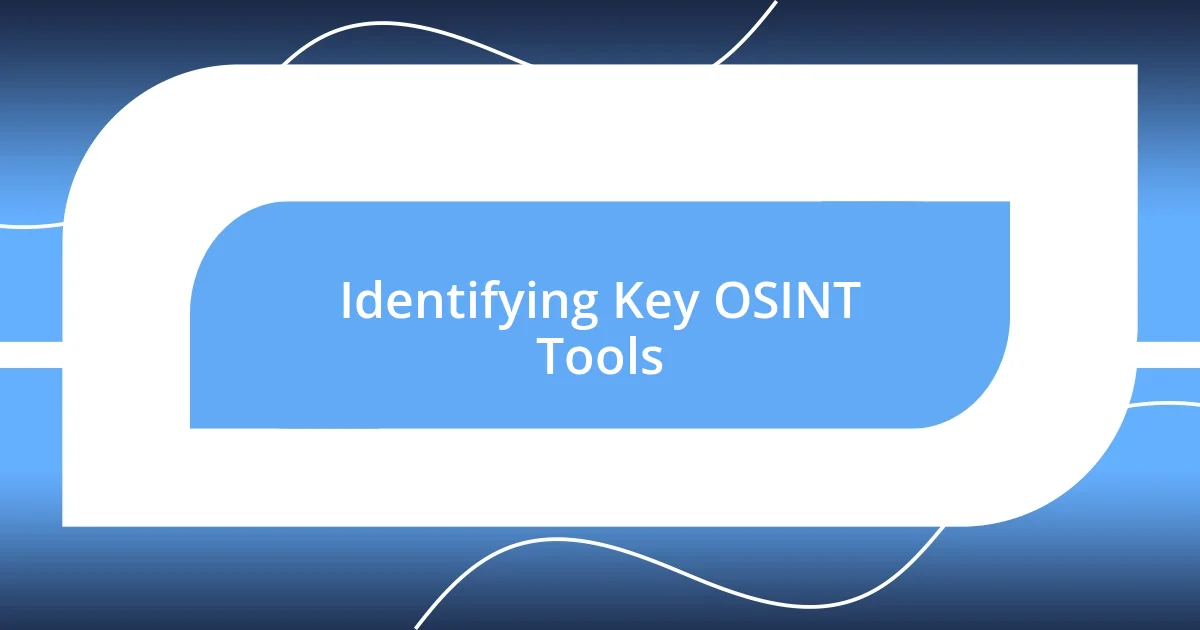
Identifying Key OSINT Tools
Identifying the right OSINT tools has become essential in my approach to hack prevention. Over the years, I’ve explored various platforms, and it’s fascinating how each tool can unveil different layers of information. I recall using a specific tool to track social media mentions of a company under threat; the insights I gathered were invaluable in forming a proactive defense strategy.
Here’s a list of some key OSINT tools I often leverage:
– Maltego: Great for visualizing relationships between entities and gathering data from various sources.
– Shodan: Provides insights into the types of devices connected to the internet, highlighting potential vulnerabilities.
– Recon-ng: A web reconnaissance tool that simplifies the process of gathering and analyzing data.
– Google Dorking: A technique using advanced search operators to find sensitive information inadvertently exposed online.
– Social-Spy: Helps monitor social media activity and detect any threat-related mentions.
Each of these tools offers unique capabilities that have saved me time and uncovered critical insights at critical moments. I’ve learned that knowing which tool to use in the right context can be a game-changer.
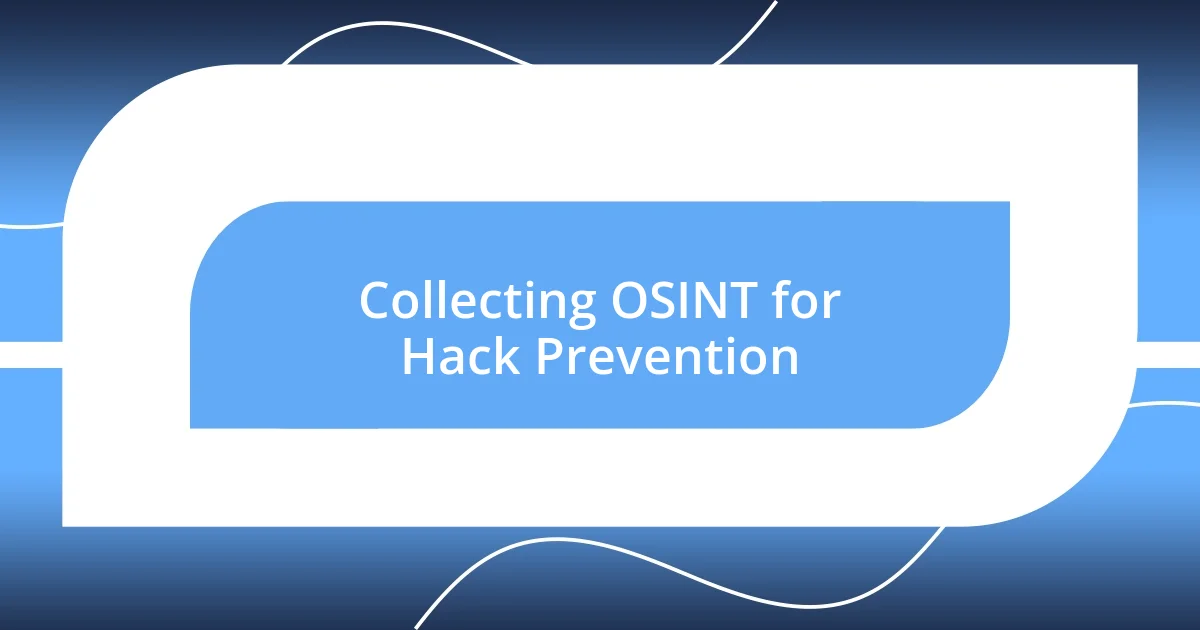
Collecting OSINT for Hack Prevention
Collecting OSINT effectively requires a systematic approach to identify and gather relevant information sources. I vividly remember a situation where I had to gather data on a potential breach in my organization. By scouring everything from social media profiles to public databases, I realized just how interconnected these sources could be. Each piece added depth to the bigger picture and helped me form a compelling narrative around the threat landscape we were up against.
As I engaged in the OSINT collection process, I learned to prioritize sources based on their credibility and relevance. For example, one time, I found a forum discussion that unexpectedly provided insights into a hacker group’s methods. It was momentous because such firsthand accounts can illuminate vulnerabilities that one wouldn’t typically anticipate. The thrill of piecing together this puzzle fueled my perseverance, reminding me of the importance of thoroughness in safeguarding networks.
To maximize my OSINT efforts, I often create a checklist of prioritized activities tailored to my specific goals. This tactic not only streamlines my approach but also keeps me focused amidst the vast amount of data available. I’ve discovered that being methodical can minimize the overwhelm often associated with information overload, allowing me to extract crystal-clear insights that serve my cybersecurity strategies better.
| Type of Source | Example |
|---|---|
| Social Media Platforms | Twitter and LinkedIn discussions |
| Public Databases | WHOIS information |
| Online Forums | Threat actor discussions |
| News Articles | Cybersecurity reports |
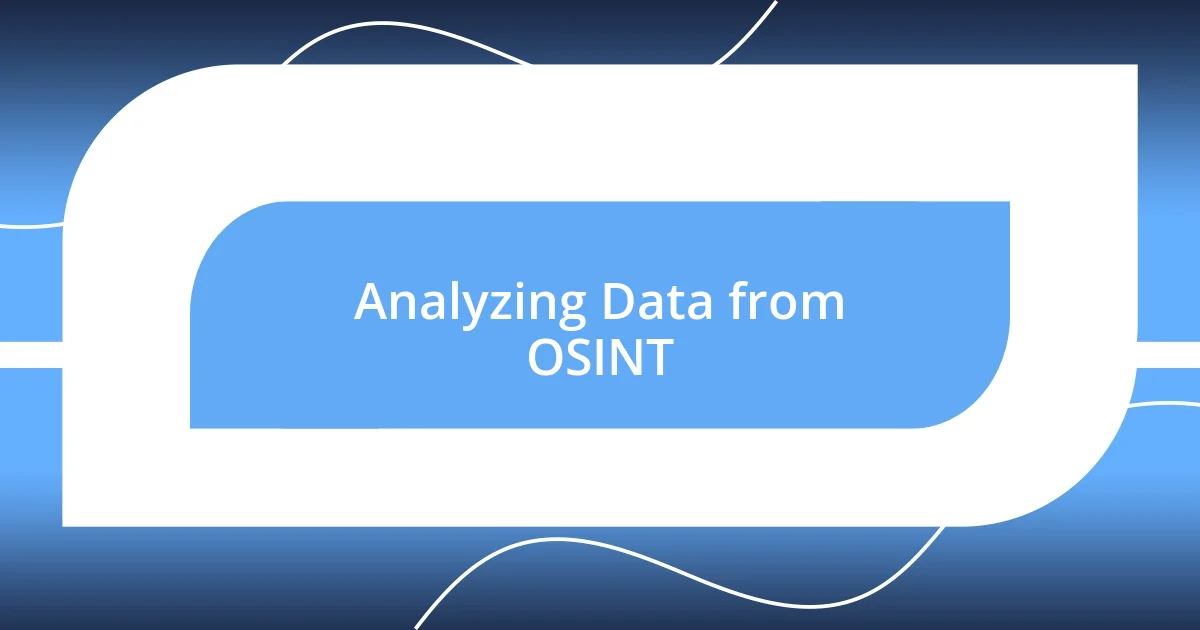
Analyzing Data from OSINT
Analyzing data from OSINT is both an art and a science, requiring a level of intuition that often comes from experience. When I delve into a dataset, I can’t help but recall a particular instance where I stumbled upon an obscure online post that hinted at a significant vulnerability. It was like finding a needle in a haystack, but once I pieced it into the broader context, the value became clear. How do I determine what data truly matters? More often than not, it’s about recognizing patterns and connecting dots that others might overlook.
As I sort through the data, I approach it with a sense of curiosity rather than mere analysis. I remember examining a string of leaks that revealed an organization’s security shortcomings. I’d felt a palpable sense of urgency when I noted a pattern: the same weak password was reused across multiple accounts. This was more than a finding—it was a wake-up call for stakeholders. I always ask myself, what story does this data tell? Engaging with the process in this way allows me to convey important insights to my team effectively.
In my experience, visualizing data can drastically enhance understanding. For instance, when I created a visual chart of attack vectors based on the OSINT I collected, it not only made the information digestible for my team but also ignited meaningful discussions about prevention strategies. Have you ever noticed how a good visual can make complex information seem less daunting? It’s this clarity, achieved through analysis, that turns data into actionable intelligence. Ultimately, I find that the goal isn’t just to analyze but to connect insights in ways that inspire proactive measures.
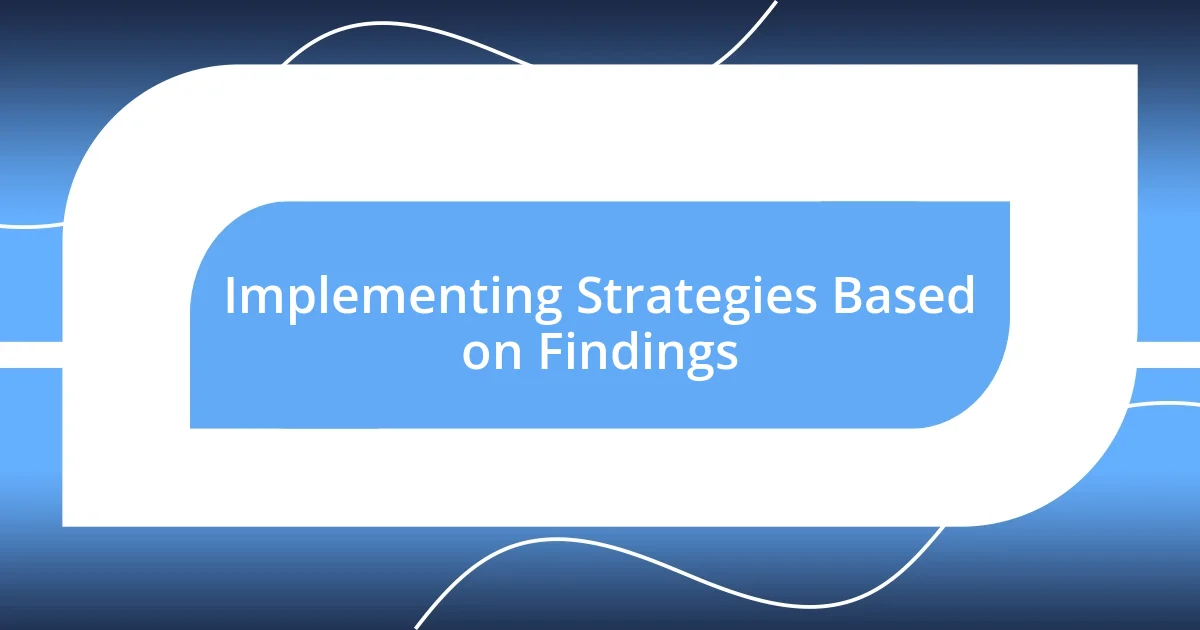
Implementing Strategies Based on Findings
When implementing strategies based on OSINT findings, it feels crucial to act swiftly and decisively. I recall a moment when a significant threat was identified through my research, and I felt an adrenaline rush as I presented my findings to leadership. We developed an action plan focusing on updating our firewall rules and conducting staff training sessions. The urgency of the situation fuelled our commitment to fortifying defenses, proving that insight alone isn’t enough; it’s the follow-through that truly matters.
One effective approach I’ve found is integrating OSINT findings into regular security training for employees. I vividly remember designing a session where I highlighted real-world implications of data breaches linked to our organization. With engaging anecdotes about recent attacks, I encouraged team members to think critically about their daily online behaviors. The emotional response I witnessed was inspiring; it sparked vibrant discussions and a collective resolve to adopt best practices. Wouldn’t you agree that connecting information with real consequences can create a truly powerful impact on a team?
Another strategy I pursue involves revisiting and recalibrating our incident response plan after each analysis. Just the other day, I revisited our protocols following a particularly insightful piece of OSINT I gathered. The knowledge that other companies in our sector were targeted due to specific vulnerabilities led me to advocate for a more proactive stance in our response plan. Every tweak and adjustment inspired by newfound insights transforms what could be a static document into a living, breathing strategy that adapts to the ever-evolving cyber landscape. Isn’t it fascinating how one piece of information can ripple through an organization, reinvigorating our approach to security?
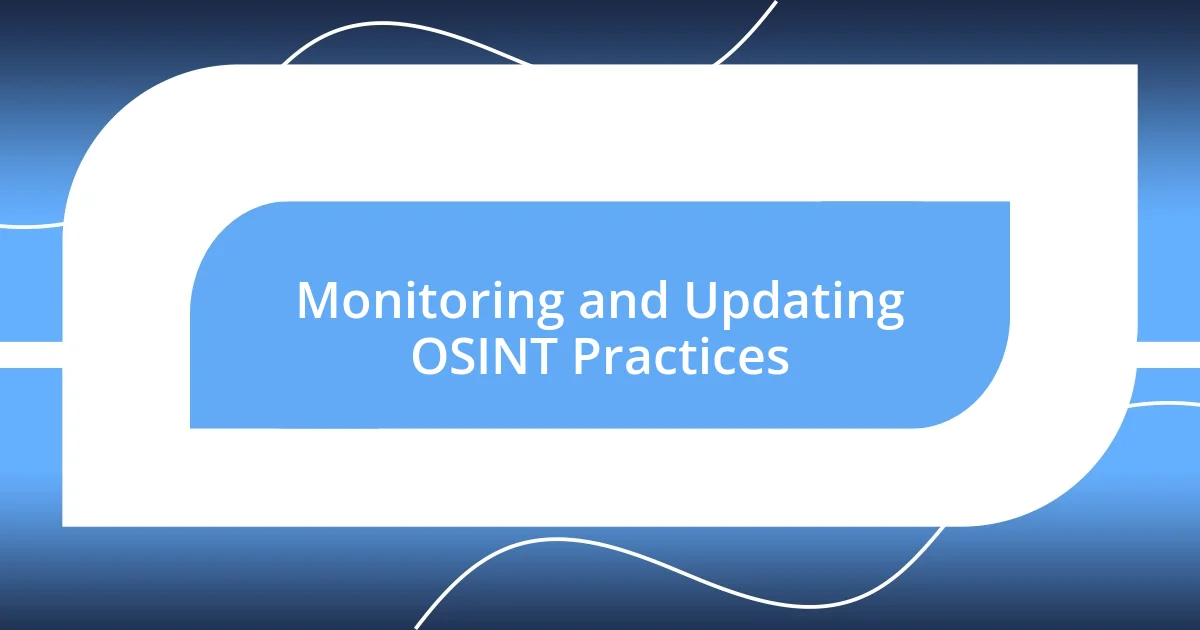
Monitoring and Updating OSINT Practices
Monitoring OSINT practices is a continuous journey, one that I embrace fully. Think of it like tending to a garden; it requires regular attention and adjustment. For instance, I once realized that a tool I initially relied on had become outdated amid new trends in data breaches. This realization pushed me to adopt more robust tools that could sift through the growing volumes of information more efficiently. How do I keep my finger on the pulse? I make it a point to join community forums and webinars that discuss emerging trends in OSINT and cyber threats.
It’s not just about updating tools, though; it’s also about the methodologies I use for analysis. A few months ago, I found that certain heuristics I employed weren’t yielding the insights they once did, so I experimented with a fresh approach. I started cross-referencing my findings more thoroughly with various sources, which helped unveil vulnerabilities I had previously overlooked. It makes me wonder, have you ever felt the thrill of discovering something entirely new simply by tweaking your analytical lens?
Furthermore, I schedule regular reviews of my monitoring processes. Each month, I sit down with my team to discuss what worked and what didn’t. Just last week, our discussion revealed a recurring theme in our data, prompting us to shift our focus towards specific threat actors. This open dialogue fosters a culture of learning and adaptation. Isn’t it eye-opening how such a simple practice can exponentially enhance our preparedness against potential threats?
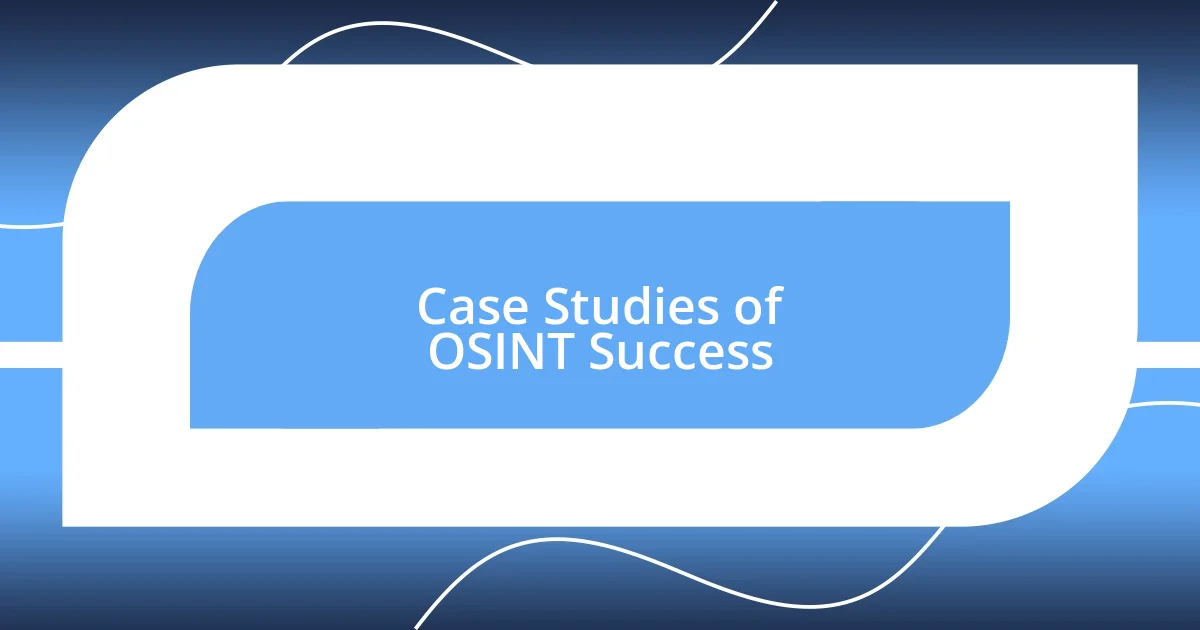
Case Studies of OSINT Success
One compelling case of OSINT success that stands out in my memory involved a financial institution that I assisted. They had been targeted by phishing campaigns, causing friction in their operations. I analyzed social media posts and dark web chatter, uncovering patterns that pinpointed a specific group targeting financial organizations. Armed with these insights, the company implemented targeted training sessions around phishing simulations, drastically reducing successful attacks. It’s a vivid reminder of how OSINT can bridge the gap between the digital landscape and practical defense strategies.
In another instance, I worked with a tech company facing repeated DDoS (Distributed Denial of Service) attacks. Through rigorous OSINT analysis, I stumbled upon a forum discussing methods to exploit vulnerabilities in their product. Feeling a sense of urgency, I brought this to their attention, and we collaborated to strengthen the product architecture. The emotional weight of knowing we likely thwarted potential damage left me with a revitalized passion for OSINT. Have you ever felt the thrill of turning insights into action that makes an immediate difference?
Lastly, a non-profit organization approached me after experiencing a data breach that severely impacted their operations. In digging through publicly available information, I found a pattern of data leaks originating from similar organizations. By presenting these findings, the non-profit rallied to collaborate with others in their sector to share intelligence and bolster overall security. It was incredible to witness how transparency and cooperation can amplify the effects of OSINT, don’t you think? There’s just something deeply fulfilling about seeing the communal strength in numbers when everyone gets on the same page.












